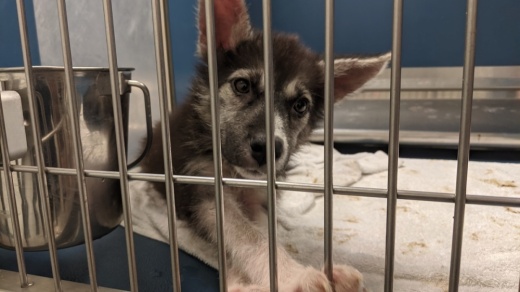It was the latest challenge facing the department, which also has experienced denied funding requests, a decline in volunteers and a rising influx of animals being dropped off by their owners in the last year.
In an Aug. 16 news release, MCAS Assistant Director Mark Wysocki said the shutdown was needed to keep the shelter’s population stable. Wysocki said the combined outbreaks came at a bad time for the shelter, which took in 1,369 animals in July and found adopters for 769.
“[The COVID-19 outbreak] is coming at the worst time for us because it’s a bad distemper year,” Wysocki said. “Either of those are a bit of managerial work. Together it’s a managerial nightmare.” Pandemic, distemper hit shelter intake
Wysocki and the shelter’s director, Aaron Johnson, have headed animal services for over five years after the county took over shelter operations in 2015 from a private operator.
One of many challenges they have faced since, Wysocki said the shelter canceled its calendar of events when COVID-19 struck in 2020, including education on vaccines for pets.
“We had a lot of plans in place, a whole calendar of off-site events we wanted to do to get to all corners of the county,” Wysocki said.
The latest wave of coronavirus cases countywide has affected staffing as well. The August outbreak was the shelter’s first, and Wysocki said staffing capacity was halved.
The pandemic hit the shelter in other ways as well. MCAS saw an increase in owner surrenders—when pet owners voluntarily turn over their animals to a shelter. Wysocki said the pandemic’s effects on jobs and households meant people who suddenly became unable to care for their pets turned to shelters for aid.
According to MCAS data, 38% of all intakes from March 10-July 31 were from owner surrenders—an increase from 28% for the same time period in both 2020 and 2019. The total intake decreased from 6,024 in 2019 to 2,673 in 2020 during the March-July time period, but in 2021 the same time frame saw that number rise to 5,372.
Wysocki attributed the rise in owner surrenders to a number of factors.
“Relocating, downsizing, house to apartment, new landlord, limits on breeds or numbers of animals, all those types of stuff,” Wysocki said. The shelter’s adoption numbers also took a hit during the pandemic: MCAS data showed from March-July 2020, there were 1,658 adoptions, or just over half the adoptions from the same time period in 2019.
Lee Ann Shenefiel, the south central regional director of Best Friends Animal Society, said there were several strategies shelters could take to manage intake and adoptions during the pandemic.
“We’re seeing more adoption by appointment, more remote technology to help manage intake,” Shenefiel said.
Wysocki said MCAS is taking adoptions by appointment.
On top of the pandemic, Wysocki said MCAS has dealt with an “especially bad” year of distemper. Distemper, caused by a virus that primarily affects dogs, attacks the nervous system and can result in permanent damage, according to the American Veterinary Medical Association.
The distemper outbreak at the shelter forced MCAS to stop intake services in August, although adopters who have observed symptoms in their animals within 30 days of adoption can return the animal without charge. Staffing, funding challenges
Shelter services have also been strained due to a lack of additional staff and funds from the county. During Montgomery County’s fiscal year 2021-22 budget presentations in July, Johnson requested a 10th animal control officer position, which county commissioners denied.
It was not the first time one of Johnson’s staffing requests has gone unanswered. MCAS provided its county budget presentations to Community Impact Newspaper, which showed from fiscal years 2018-22, the department requested 16 new positions ranging from veterinary technicians to adoption coordinators, none of which were approved. Two positions received upgrades in pay and responsibilities in FY 2018, but MCAS’ full-time headcount has not increased from 55 since 2016, Wysocki said.
Wysocki attributed the lack of new staffing to the county responsibilities the commissioners have to balance. He also said county leadership has been more receptive to the shelter’s mission since he and Johnson took over.
“The commissioners have the unenviable job of balancing the needs of everyone in Montgomery County,” Wysocki said. “We are responsible for meeting the needs of the pets of Montgomery County.”
County Judge Mark Keough declined to comment as of press time. Wysocki said he believes a shelter aiming to meet the needs of Montgomery County would have double the staff it has, especially considering the county’s growth. In FY 2020-21, MCAS had 237 registered volunteers, a steep drop from 1,742 in 2018-19. Volunteer coordinator Jill Becker said in an email that MCAS volunteer orientation stopped from March-December 2020.
“If you look at population and therefore the assumed pet population, median income, intake, what a good staffing level should be based on care for animals, any one of those criteria, we are still underfunded,” Wysocki said. “We are definitely better than we were, but we’re still not where we need to be.”
U.S. Census Bureau data from 2020 shows Montgomery County’s population grew 36.1% since 2010. Both Wysocki and Shenefiel said they believe animal shelters should represent their surrounding communities, including their populations.
“What happens in a shelter is a reflection of what’s happening in the community,” Shenefiel said. “People move into a community, bring pets with them, and the shelter may not be equipped to manage that increased pet population.”
Further staffing issues at the shelter include high turnover rates due to emotional turmoil. According to Wysocki, staff can get invested in an animal’s well-being, which can lead to high stress over their care and future, but there are positive emotions involved as well, such as a person’s first adoption.
“The issues we deal with are emotional issues,” Wysocki said. “There’s a very high compassion fatigue and suicide rate in animal welfare, and I think a lot of people don’t realize it.”
Shelter plans
Another point of discussion during Johnson’s July presentation was the construction of a new animal shelter. County commissioners authorized Johnson to begin gathering data for what the shelter would look like.
For Nelda Blair, the president of the nonprofit Humane Society of Montgomery County, that step involves creating a short-term plan and a long-term goal for the society. Blair said the society had been discussing a new shelter with MCAS and the county for a few years, and she believes it would foster a greater vision for animal welfare countywide.
“The county would be the main entity building the shelter, but their obligation only goes so far,” Blair said. “So if we want enhanced services at a county shelter, we’ll have to raise funds or find other ways to pay for it. Our real desire is that [animal welfare groups] can get together and do what we can to make the shelter we really, really need in this county.”
Blair said the Humane Society would provide some funding, but the details would come from MCAS. Both Blair and Wysocki said the parties have only begun discussions, and neither could provide cost estimates.
Wysocki said MCAS would prioritize designated spaces for shelter services with a new shelter. With the current setup, several areas of the building handle multiple functions at once.
“Everything used to happen in this lobby, whether it was a person getting their first puppy or a dog getting euthanized,” Wysocki said. “Ideally we would like to have separate spaces so people could come to the shelter to do what they need to.”
Other improvements would include larger living spaces for the animals. When the shelter reached critical capacity in May, Wysocki said often two or three animals were in a kennel.
“Having two or three animals in a kennel, as a standard, is not good,” he said. “Once we start doubling animals, it becomes harder to do enrichment like throwing toys into the kennel.”





